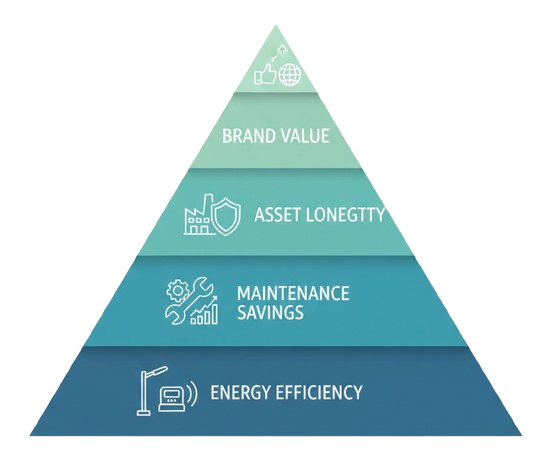IoT in infrastructure used to feel like a future experiment.
Today, it is a clear business tool.
Private townships, industrial parks, and tech campuses are now the early adopters.
They move faster than government projects.
Why? Because IoT saves money.
Every smart streetlight, smart meter, or predictive alert cuts operating costs and pays back quickly.
The New Business Case for IoT
Smart infrastructure is not about fancy gadgets.
It is about data, control, and lower costs.
| Business Goal | IoT Benefit | ROI |
| Cut Energy Costs | Smart dimming, motion-based lighting | 50–70% savings |
| Reduce Maintenance | Remote monitoring, fault detection | 30–40% labor reduction |
| Extend Asset Life | Predictive analytics | +25% equipment life |
| Boost Sustainability | Automated consumption tracking | ESG-ready |
| Increase Market Value | “Smart township” branding | Higher trust & faster sales |
Private developers now use IoT as a profit tool, not just an engineering upgrade.
How IoT Delivers Real ROI
A. Energy Efficiency
Smart lighting adjusts to daylight and movement.
The result is simple: lower bills.
Many projects see a 60% drop in electricity use.
Lights no longer run at full power all night.
You can track carbon savings in real time.
Example:
A township with 1,000 streetlights can save ₹6–8 lakh per month after automation.
B. Better Operations
Smart meters remove manual readings.
Remote monitoring lets one technician manage many sites.
Work that needed 10 people can now run with 2.
This means fewer errors and smoother operations.
C. Predictive Maintenance
Sensors send alerts before equipment fails.
Streetlights report voltage drops or faulty drivers automatically.
No more random patrols.
This reduces downtime and can cut maintenance costs by 40%.
D. ESG and Sustainability
If you want green certifications, IoT helps a lot.
You can track energy use, water use, and carbon impact in real time.
This supports brand value and may unlock green financing.
ROI Snapshot: What Developers Actually Save
| Infrastructure | Automation Impact | Yearly Savings | ROI Period |
| Smart Streetlights | Adaptive brightness, fault alerts | ₹70–90 lakh | 18–24 months |
| Smart Energy Meters | Remote reading, tamper alerts | ₹25–40 lakh | 12–18 months |
| Water Monitoring | Leak detection, pressure control | ₹15–30 lakh | 24–30 months |
| Waste Management | Fill-level sensors | ₹10–20 lakh | 24–36 months |
A mid-sized township can save ₹1–2 crore every year.
These savings repeat every year and grow over time.
Why Private Developers Move Faster Than Public Projects
Government smart city projects face long approval cycles.
Private developers do not.
| Factor | Public Smart City | Private Township |
| Decision Cycle | Multi-agency | Direct ownership |
| ROI Timeline | 3–5 years | 1.5–2 years |
| Data Ownership | Shared | Full control |
| Customization | Standardized | Flexible |
| Accountability | Political | Business-driven |
This speed makes IoT profitable and practical for private developers.
Why Data Makes ROI Even Better
IoT platforms give dashboards that:
- Track energy use live
- Predict demand
- Show faulty devices
- Connect with ERP or BMS systems
This leads to nonstop optimization.
Your systems get better every month.
The Ripple Effect on Brand and ESG
Buyers want modern, tech-enabled spaces.
So do tenants and investors.
Smart infrastructure helps developers:
- Stand out in the market
- Build trust
- Meet sustainability goals easily
It has become the “solar panel effect” of this decade—visible proof of innovation.

What Comes Next: Mini Smart Cities
Private campuses and townships are becoming micro smart cities.
They control their own grids, security systems, and utilities from a central command center.
New tech will improve ROI even more:
- AI-driven demand prediction
- EV charging analytics
- Digital twins for planning
